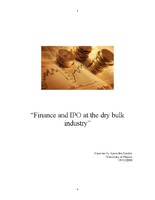| dc.description.abstractEN | Generally, nothing stands in vacuum. For all aspects of human behavior and for every action, there are a number of past incidents that form the present and help predict the future. Thus, history can be seen as the backbone of all disciplines and it can be used as a tool to understand human behavior. Furthermore, to an extent, by studying history, someone can gain competitive insight into a number of sectors of human activities, like the shipping sector (which is of interest here). In order to achieve this, what is needed is a thorough examination of the shipping finance history’s roots. The capital intensiveness of the sector makes it crucial to draw our attention to the financing of the industry. Transportation of goods by sea is by far the oldest mode of transportation that dates back to ancient times and merchant nations, namely the Phoenician era. Traditionally, shipping has been the cheapest mode of transportation. Given the fact that almost three fourths of the earth is covered by water and due to the low costs of origin to destination infrastructure coupled with the competitive advantage in power (due to friction), two thirds of the world’s trade is transported by sea. In numbers, it is estimated that merchant ships are transporting more than $5 billion tons of cargo per year. Shipping is one of the most capital-intensive industries worldwide. Its assets have been estimated around $591 billion (Vergotis, 2001). This number can easily highlight the importance of financing in the shipping sector. At this point, what is needed is an overview of the ways ships have been historically financed and how ship finance has contributed both to the success as well as the problems in the shipping industry, and its cycles. | |



